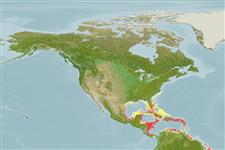Demospongiae |
Poecilosclerida |
Iotrochotidae
Environment: milieu / climate zone / depth range / distribution range
Ecology
Sessile. Tropical
Western Central Atlantic.
Length at first maturity / Size / Weight / Age
Maturity: Lm ? range ? - ? cm
Thick encrustations on an accumulation of sand and rubble, seemingly partly buried. Surface dirty with sediment. Feels rugged when handled, but appears smooth when dermis is stretched. Black in situ, dark purple when stored. Surface is soft, fibers tough. Purple mucus exudate that stains the hands. Oscules not apparent (Ref. 85482).
Found in sand and rubble on coral reefs. Also in lagoons, mangroves, and pilings. Known from depths between 0.1 to 45 m (Ref. 85482).
Life cycle and mating behavior
Maturity | Reproduction | Spawning | Eggs | Fecundity | Larvae
Members of the class Demospongiae are hermaphroditic. Life cycle: The zygote develops into parenchymella larva (free-swimming) before settling down on a substrate where it grows into a young sponge.
Zea, S., T.P. Henkel and J.R. Pawlik 2009 The Sponge Guide: a picture guide to the Caribbean sponges. Available online at http://www.spongeguide.org. Accessed on:2009-07-19. (Ref. 81728)
IUCN Red List Status
(Ref. 130435: Version 2025-1)
CITES status (Ref. 108899)
Not Evaluated
Not Evaluated
Threat to humans
Harmless
Human uses
| FishSource |
Tools
More information
Trophic EcologyFood items (preys)
Diet composition
Food consumption
Predators
Population dynamicsGrowth
Max. ages / sizes
Length-weight rel.
Length-length rel.
Length-frequencies
Mass conversion
Abundance
Life cycleReproductionMaturityFecunditySpawningEggsEgg developmentLarvae PhysiologyOxygen consumption
Human RelatedStamps, coins, misc.
Internet sources
Estimates based on models
